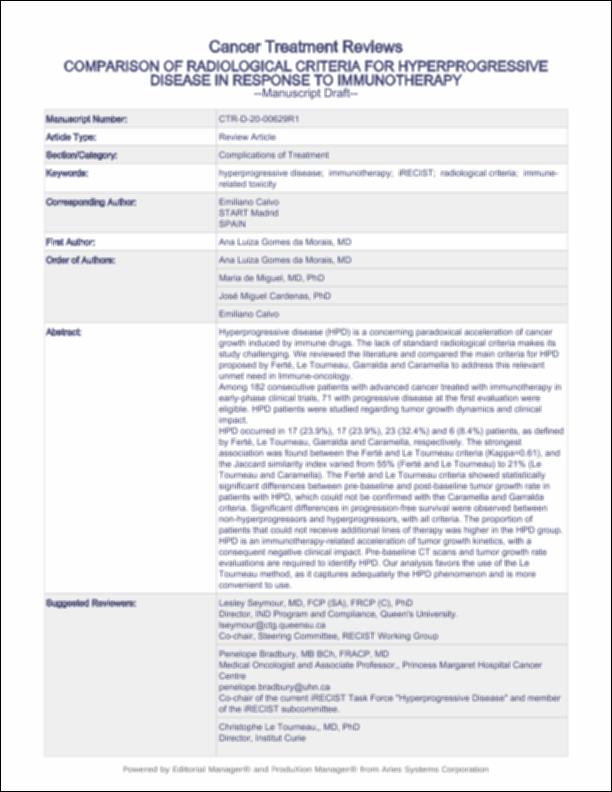Please use this identifier to cite or link to this item:
http://hdl.handle.net/10637/15210Comparison of radiological criteria for hyperprogressive disease in response to immunotherapy

See/Open:
Comparison_Gomes_et_al_Cancer_Treat_Reviews.2020pdf
Restricted Access
1,7 MB
Adobe PDF
Request a copy
| Title: | Comparison of radiological criteria for hyperprogressive disease in response to immunotherapy |
| Authors : | Gomes de Morais Wiermann, Ana Luiza Miguel, María de Cárdenas Rebollo, José Miguel Calvo Aller, Emiliano |
| Keywords: | Hyperprogressive disease; Immune-related toxicity; Immunotherapy; Radiological criteria; iRECIST |
| Publisher: | Elsevier |
| Citation: | Gomes da Morais AL, de Miguel M, Cardenas JM, Calvo E. Comparison of radiological criteria for hyperprogressive disease in response to immunotherapy. Cancer Treat Rev. 2020 Dec;91:102116. doi: 10.1016/j.ctrv.2020.102116. Epub 2020 Oct 29. PMID: 33157360. |
| Abstract: | Hyperprogressive disease (HPD) is a concerning paradoxical acceleration of cancer growth induced by immune drugs. The lack of standard radiological criteria makes its study challenging. We reviewed the literature and compared the main criteria for HPD proposed by Ferté, Le Tourneau, Garralda and Caramella to address this relevant unmet need in Immune-oncology. Among 182 consecutive patients with advanced cancer treated with immunotherapy in early-phase clinical trials, 71 with progressive disease at the first evaluation were eligible. HPD patients were studied regarding tumor growth dynamics and clinical impact. HPD occurred in 17 (23.9%), 17 (23.9%), 23 (32.4%) and 6 (8.4%) patients, as defined by Ferté, Le Tourneau, Garralda and Caramella, respectively. The strongest association was found between the Ferté and Le Tourneau criteria (Kappa = 0.61), and the Jaccard similarity index varied from 55% (Ferté and Le Tourneau) to 21% (Le Tourneau and Caramella). The Ferté and Le Tourneau criteria showed statistically significant differences between pre-baseline and post-baseline tumor growth rate in patients with HPD, which could not be confirmed with the Caramella and Garralda criteria. Significant differences in progression-free survival were observed between non-hyperprogressors and hyperprogressors, with all criteria. The proportion of patients that could not receive additional lines of therapy was higher in the HPD group. HPD is an immunotherapy-related acceleration of tumor growth kinetics, with a consequent negative clinical impact. Pre-baseline CT scans and tumor growth rate evaluations are required to identify HPD. Our analysis favors the use of the Le Tourneau method, as it captures adequately the HPD phenomenon and is more convenient to use. |
| Description: | Acceso al texto completo del artículo, disponible desde el sitio de la revista usando DOI: https://doi.org/10.1016/j.ctrv.2020.102116 |
| URI: | http://hdl.handle.net/10637/15210 |
| Rights : | http://creativecommons.org/licenses/by-nc-nd/4.0/deed.es |
| ISSN: | 0305-7372 |
| Issue Date: | 29-Oct-2020 |
| Center : | Universidad San Pablo-CEU |
| Appears in Collections: | Enfermería |
Items in DSpace are protected by copyright, with all rights reserved, unless otherwise indicated.

